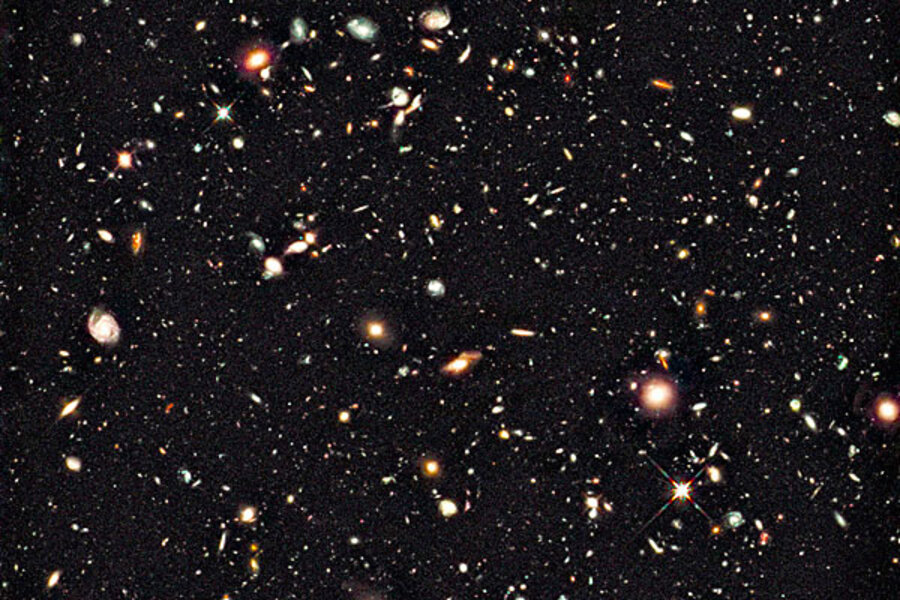Hubble telescope glimpses universe's earliest galaxies
Loading...
The recently refurbished Hubble Space Telescope has drawn back a curtain on a group of galaxies that are the earliest the universe has yet produced.
The galaxies, hot, small, and blue, appear as faint patches of fuzz in the image Hubble took of a patch of sky over four days last August, peering back into a period when the cosmos was only 600 million to 800 million years old - less than one-twentieth of its current age - and a little more than 10 percent of its current size.
In addition these early galaxies, the international team of scientists reporting the results Tuesday say their "ultra-deep field" image contains at least three galaxy candidates that existed when the universe was some 500 million years old. They remain candidates because they are too faint for detailed study.
The discoveries help mark a watershed in modern astronomy and cosmology, according to John Grunsfeld, one of the astronauts who helped repair and refurbish Hubble last May and who has just been appointed as deputy director of the Space Telescope Science Institute in Baltimore.
Just a hundred years ago, astronomers such as Edwin Hubble were debating the nature of "nebula" they saw in the night sky – cloudy patches of light that we now know as galaxies. At that time, "we didn't know we lived in a universe where we could see the beginning of star formation and galaxies," Mr. Grunsfeld said at a briefing at the winter meeting of the American Astronomical Society in Washington, D.C.
"This is a remarkable time,” he said, thanks to some remarkable tools that are helping push the frontiers of astronomy.
After the Big Bang
Interest in the universe’s first billion years is running high because it marks a critical phase in the universe’s evolution.
The universe is thought to have begun some 13.7 billion years ago with an energetic burst known as the Big Bang. As the universe expanded and cooled, the building blocks of matter began to distill from the seething soup of higher-energy particles the Big Bang created. The universe cooled to the point where it was populated by run-of-the-mill molecules. Roughly 75 percent of the matter in the universe was hydrogen, 25 percent helium, along with traces of a small handful of other elements. No stars shone. No galaxies pirouetted.
At some point between 100 million and 1 billion years after the Big Bang, cosmologists calculate, the universe slowly began to switch on the lights. The cosmos shifted from the cold and opaque aftermath of the Big Bang to a transparent universe filled with the dazzling display of stars, galaxies, galaxy clusters, and super clusters that humans gaze on today.
"We don't know who pulled the trigger" on this period, known as re-ionization, says Rogier Windhorst, a cosmologist at Arizona State University in Tempe, Ariz., and a member of the Hubble team.
But some of the leading candidates are early galaxies, he says, such as those in the new Hubble ultra-deep field image. They are likely to have been among the early sources of radiation that ionized the molecular hydrogen between galaxies, allowing light to shine throughout the small but expanding universe.
Missing link in galaxy growth
These newly spotted galaxies also represent important "missing links" along the line of galactic evolution, from the first small fragments to the later sprawling spiral and elliptical galaxies tens of thousands of light-years across, including the Milky Way. The team estimates that the earliest galaxies found so far in their survey are only 5 percent of the size of the Milky Way with 1 percent of the Milky Way's mass. At least during the universe's first 2 billion years, galaxies assembled themselves from smaller bits in along a relatively smooth trajectory, the team's data suggest.
"These are the seeds of the great galaxies of today," says Garth Illingworth, a researcher at the University of California at Santa Cruz who led the Hubble observation team.
The stars in the galaxies reported Tuesday show traits that models suggest the universe's first stars would display.
They are "so blue that they must be extremely deficient in heavy elements," notes team member Rychard Bouwens, also at the University of California at Santa Cruz. Those heavy elements, present in varying abundances in today's stars and galaxies, form in the nuclear-fusion furnaces at the heart of every star. Stars shed those elements through their lifespans, and especially at the end of their existence. Succeeding generations of stars sweep up these elements as they form so that on average, later generations become redder and somewhat cooler.
That means the blue stars corralled in the galaxies found in the Hubble survey thus represent a population of stars "that has nearly primordial characteristics," Dr. Bouwens explains.
What the next telescope may discover
Hubble' results leave many astronomers eagerly awaiting the James Webb Space Telescope (JWST), scheduled for launch in 2014. The sizes of the fledgling galaxies in the latest Hubble survey hint at a fairly quick onset of galaxy formation after the Big Bang – a birthing period well within the JWST's detection abilities.
The stars in the tiny galaxy-wannabes are already several hundred million years old, scientists found in combining data from Hubble and the Spitzer Space Telescope.
"JSWT is going to be the telescope that will really reveal these galaxies in their glory and galaxies at earlier times," Dr. Illingworth says.
---
Follow us on Twitter.





